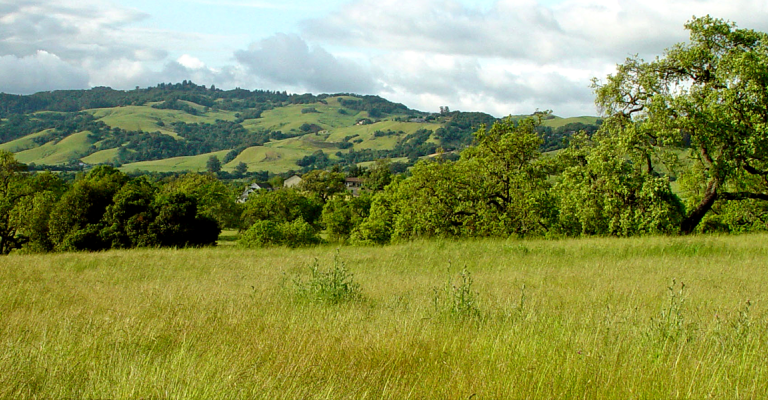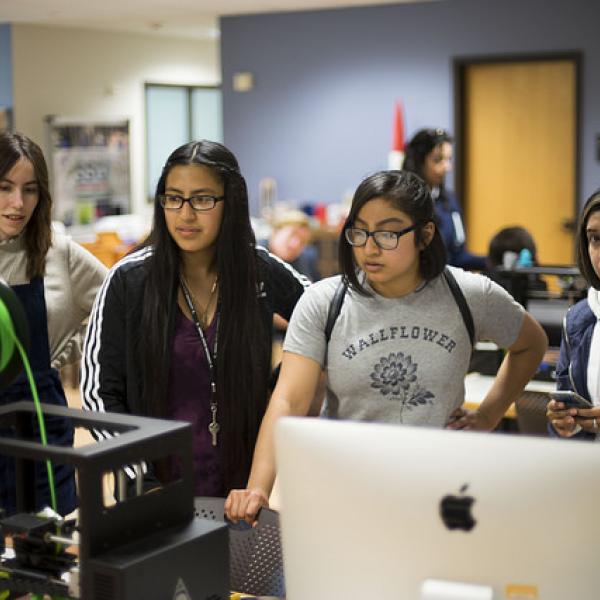Service-Learning in University Studies
University Studies at SSU includes both transition and leadership classes. The CCE can help you connect with an instructor with experience with service-learning. We can also help you create or deepen your service-learning class. We provide models of other courses, sample syllabi, resources for course construction, reflective analysis tools, and risk management support. Please contact [email protected] for more information.
Transition programs have multiple goals that service-learning pedagogy addresses. According to the AAC&U, both service-learning and transition programs are high impact practices. Transition courses were early adopters of service-learning because the pedagogy provided students with an activity that connects to the course content and provides a retention-supporting bonding experience while also providing students with a sense of place. Forming connections to peers and faculty is seen as a crucial element for retention—especially for women, students of color, first-generation students, and students who do not otherwise fit the traditional college student description. First-year experience courses were introduced and designed to function as a way to increase retention beyond the first year of college (Mandel and Evans 2003). Lower level introductory courses typically place more emphasis on activities that provide concrete and active experiences for students. Milem and Berger (1997) note that involvement during the “first six to seven weeks of a semester” is significantly related to retention. Transition courses are viewed as a prime target to initiate this kind of involvement (Colby, et al. 2003). There is evidence that service-learning increases the likelihood of persistence because it facilitates greater student involvement and interaction with peers and with faculty. Typical goals of transition programs involve integrating students into the college community by creating an environment conducive to bonding with peers to make friends, meeting faculty, and learning about what is available to them in the university.
Service-learning activity usually falls into two categories:
Type 1: Teaching/tutoring/sharing knowledge from the class.
EXAMPLE: At the University of Rhode Island, freshmen can enroll in a course called URI 101 which serves as the first-year experience for students who are transitioning into college. These courses are designed to also function as cohorts with specific focuses for different majors like music, hunger, nonviolence and peace studies, diversity, leadership, etc. Students then take material learned in class and teach the community they are partnered with. For example, music majors who participated in a music appreciation project spent a semester coordinating a music appreciation workshop for seniors at a local retirement home. “By sharing common courses, students find that they work more in groups, focusing on academic issues outside of class...and feel better ‘known’ by their teachers and peers” (Richmond 2002).
Type 2: Using information from the class to do something with/for a community organization.
EXAMPLE: Portland State University integrates an introductory community experience into their first-year program called Freshman Inquiry courses. These courses are assigned themes that correspond to various disciplines. The “Knowledge, Art, and Power” theme allowed students to work with the Portland Art Museum “to guide middle school students through current exhibits and to research and write exhibition catalogs” (Williams et. al 2002). Students have reflected and reported, “an increased sense of self-confidence, a feeling of connection to those with whom they worked, and a greater awareness and understanding of different populations in Portland” (Williams et. al 2002).
Leadership development courses share many goals with service-learning, which include developing both critical thinking skills and a sense of ethics or what is sometimes called value learning (McInnis 2001; Mandel and Evans 2003; Barefoot 2000b). Others have argued that the integration of service-learning into the leadership classroom can increase student learning and interest, heighten respect for diversity, and increase students' sense of social responsibility (O'Byrne and Alva 2002; Barefoot 2000b; Zlotkowski 2002). Some other benefits of service-learning include cognitive-skills development, moral development, and values formation, greater civic involvement, and a greater appreciation for diversity (Marullo 1996). Invested, active students are more likely to flourish academically and personally and to persist toward graduation. Involvement, moreover, might be most advantageous toward the beginning of a student’s career (Vogelgesang, et. al, 2002).
Type 1: Teaching/tutoring/sharing knowledge from the class.
EXAMPLE: The leadership studies course sequence at the Staley School of Leadership Studies at Kansas State University (KSU) gave students a chance to learn about leadership and community building and then apply their knowledge to a service-learning project. KSU students in this program were given the option to identify a collective challenge. After learning about orphanage tourism and the negative effects of good intentions on children's livelihoods around the world, the students chose to work together on this particular issue. The course was organized so students learned about the issue, considered the values involved in leading advocacy and education on the issue, and reflected on their leadership contributions to the team and public activities in the process. During the first semester of the course, students learned about the specific challenge of orphanage tourism and considered concepts central to leadership and social change. The students collaborated on campus‐based awareness‐raising events with the community partner, a broad interagency network of child protection organizations. The end of the course consisted of further leadership studies and collective reflection, where one student wrote about her improved ability to work in a team: “I believed that I alone could control responsibility [for collaborative projects]. I did this until this leadership class, where that reign was taken by others” (Hartman, 2016).
Type 2: Using information from the class to do something with/for a community organization.
EXAMPLE: CSU Fullerton has a class designed to teach students about civic engagement and give them the tools to develop leadership skills and explore career options. In the past, political science service-learners have partnered with the local city council to help coordinate voter registration drives.
References:
Barefoot, B. O. (2000a). "National survey of first-year curricular practices summary of findings." Policy Center on the First Year of College. Retrieved May 5, 2005. 2000b. "The first-year experience: are we making it any better? About Campus January-February, 12-18.
Gardner, J. N. (2002). "What, so what, now what: reflections, findings, conclusions, and recommendations on service-learning and the first-year experience." In E. Zlotkowski (Ed.), Service-learning and the first-year experience: Preparing students for personal success and civic responsibility (Monograph No. 34), (pp. 141-150). Columbia, SC: the University of South Carolina, National Resource Center for The First-Year Experience and Students in Transition.
Hartman, E. (2016). “Decentering Self in Leadership: Putting Community at the Center in Leadership Studies”. New Directions for Student Leadership. Vol. 2016 Issue 150, 73-83.
Marullo, S. (1996). "Sociology's contribution to the service-learning movement." In M. G. Ender, B. M. Kowalewski, D.A. Cotter, L. Martin, and J. DeFiore (Eds.), Service-learning and undergraduate sociology: Syllabi and instructional materials (pp. 1-10). Washington: ASA Teaching Resource Center.
O'Byrne, K., & Alva, S. A. (2002). "Service-Learning in a Learning Community: The Fullerton First-Year Program." In E. Zlotkowski (Ed.), Service-learning and the first-year experience: Preparing students for personal success and civic responsibility (Monograph No. 34), (pp. 115-124). Columbia, SC: the University of South Carolina, National Resource Center for The First-Year Experience and Students in Transition.
Richmond, J. (2002). “The University of Rhode Island’s New Culture for Learning”. Service-Learning and The First-Year Experience: Preparing Students for Personal Success and Civic Responsibility. Campus Compact. The University of South Carolina, 65-77.
Vogelgesang, Lori J., Ikeda, Elaine K., Gilmartin, Shannon K., & Keup, Jennifer R. (2002). "Service-Learning and the First-Year Experience: Outcomes Related to Learning and Persistence." In E. Zlotkowski (ed.), Service-Learning and the First-Year Experience: Preparing Students for Personal Success and Civic Responsibility (pp15-24). University of South Carolina: National Resource Center for the First-Year Experience & Students in Transition.
Williams, Dilafruz, Patton, Judy, Beyler, Richard, Balshem, Martha, & Halka, Monica (2002). “Inquiry as a Mode of Student Learning at Portland State University: Service-Learning Experiences in First-Year Curriculum”. Service-Learning and The First-Year Experience: Preparing Students for Personal Success and Civic Responsibility. Campus Compact. The University of South Carolina, 91-105.
Zlotkowski, E. 2002. "Service-Learning and the Introductory Course: Lessons From Across the Disciplines." In E. Zlotkowski (Ed.), Service-learning and the first-year experience: Preparing students for personal success and civic responsibility (Monograph No. 34), (pp. 27-36). Columbia, SC: the University of South Carolina, National Resource Center for The First-Year Experience and Students in Transition.



